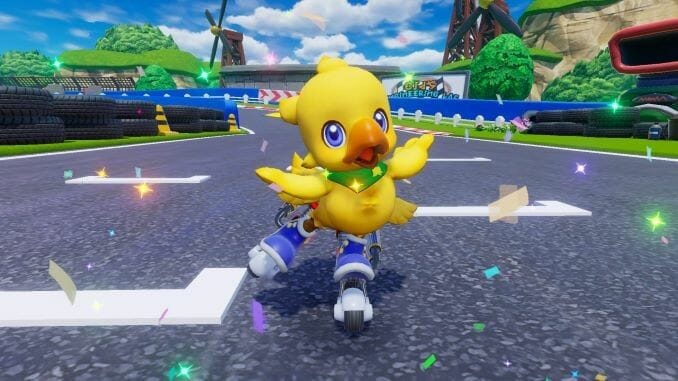Chocobo Racing and Gran Turismo are two wildly different answers to the same basic question.
Both involve driving a vehicle faster than your opponents, and both boast a respectable single player campaign of races to complete. Now if we’re talking series-wide, the comparisons really end there. But it also happens that with their respective releases last month, both were restructured in 2022 to include microtransactions.
The full priced version of Chocobo GP starts by pushing players towards a totally passable story mode that gradually unlocks most of the roster for you over the handful of hours it takes to complete. The story is mostly just a vehicle to crack RPG jokes and break the fourth wall, but the brevity and drip feed of cute characters make it work.
Longtime Final Fantasy character designer Toshiyuki Itahana’s rendering of a Chocobo is quite simply one of the cutest mascots of all time. And the other reimaginings of series staples like Shiva and Gilgamesh are no slouch either. It’s once the story mode is finished that the insidious stuff starts to make itself known.
Outside of story mode, Chocobo GP is a battle royale kart racing game where 64 players race in a four round bracket until there are eight people left racing for first place.The moment to moment racing takes some time to learn, but in some ways feels more deliberate than Mario Kart does at its best.
There’s still rubber banding and the possibility of getting wrecked in the last lap if you’re really unlucky, but for the most part it feels like Chocobo gives you more ways to defend yourself than Mario Kart ever has.
Unfortunately Chocobo GP also includes no less than three hard and soft currencies, and a painfully slow battle pass to work through. The rewards on the time limited pass are mostly meager offerings like in-game wallpapers and reusable stickers until you reach Mr. Final Fantasy VII himself: Cloud Strife.
Cloud is only obtainable by grinding at a glacial pace through the reward progression or making a $90 in-app purchase in the game you just paid $50 for. And if neither of those options sound weird enough for you, you can also spend consumable multipliers each time you race to quadruple your progress.
I can easily see a younger version of myself stumbling into caring about this miserly reward system and being driven to play the game in ways I otherwise wouldn’t without those incentives in place. I’d like to think kids today are cooler and generally being pulled in more directions than I was back then. But the fact is, deploying Itahana’s masterful character designs alongside a battle pass and business model made to sink its false scarcity hooks into you leaves a bad taste.
Gran Turismo 7 doesn’t experiment with every kind of monetization it can fit under its hood like Chocobo GP, but its sole dedication to driving purchases through false scarcity actually makes it feel more blatantly anti-consumer.
Some folks have more money than time, and Gran Turismo 7 is tuned in multiple ways to drain these people above all else. This “whale” model is pretty standard as far as free-to-play games go, but it’s wild to see how shameless Polyphony Digital are willing to get with it in a numbered Gran Turismo sequel. The 39 challenges that make up the game’s campaign task you with one of three objectives. Complete this series of races, go engage with some newly unlocked feature, or collect these three cars. The latter feels the most common, and to the average player this usually just means completing three races that reward those specific cars for free.
The fact that the top three slots in the “used car” shop are usually just the three cars you need for a given challenge is emblematic of where the game’s at now, though. It’s happy to let you engage with the finely-tuned systems that make it one of the best driving sims I’ve ever played, or subvert them entirely with your credit card.
There are not one but two constantly rotating stores featuring the rarest cars in the game’s catalog. Some of these cars cost almost $200 in a game you can’t even boot up without dropping $70 to start. And if that’s not enough, Polyphony kicked the proverbial wasps nest recently by cutting out ways for players to grind out credits. [For more information on Gran Turismo 7’s microtransactions, check out Jackson Tyler’s article from last week.—Ed.)
Polyphony Digital President Kazunori Yamauchi has since responded to the torrent of public backlash by outlining a number of make-goods planned for the game starting in April. Between doubling the payout for some races, and the promise that players will eventually be able to sell cars for credits, a lot of these changes honestly feel like a step in the right direction. But it’s a shame that they weren’t content to just make a stellar driving sim and leave it at that.
Sadly a game pulling this kind of ploy in 2022 isn’t surprising—not in the slightest. But I remember pulling Gran Turismo 2 and Chocobo Racing down from my dad’s game shelf as a kid, giving the two games a try and coming to a separate conclusion about each that these were big kid games I wasn’t quite ready for. I can only hope that the kids who find themselves in front of these iterations reach the same conclusion before long—and without reaching for their parents’ credit cards first.
Yousif Kassab writes about games, music and manga on the internet. You can find him on Twitter at @Youuuusif (four U’s).